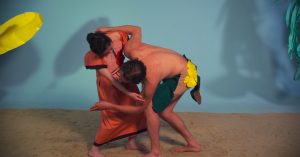ARTIST |
Glauco Rodrigues |
TITLE |
Yes Nós Temos Bananas |
YEAR |
1968 |
ARTIST’S COUNTRY OF ORIGEN |
Brazil |
DIMENSIONS |
180 x 86 cm |
MEDIUM |
Serigraph print on silk |
Credits: Courtesy of Bergamin & Gomide
Yes Nós Témos Bananas was first exhibited at the open-air event Bandeiras na Praça General Osório, a combination of exhibition and art fair, organised by a group of artists in Rio de Janeiro in 1967. In the event, also known as the “happening of the flags”, artists such as Nelson Leirner, Flávio Mota, Carlos Scliar, Hélio Oiticica, Marcelo Nietsche, Carlos Vergara, Rubens Gerchman, Anna Maria Maiolino, Petrina Checcacci and Cláudio Tozzi also participated. They hung flags and banners from the trees and balconies of a public square. Hélio Oiticica created his famous Séja marginal, séja heroi for this event, a work that would go on to become a landmark of Brazilian radical art. With a festive atmosphere, the event also featured percussion from the Mangueira samba school and the recently formed Banda de Ipanema, today one of the main acts of the Rio Carnival.
In those times, Brazil was under a military dictatorship and a few weeks after the event, the student, Edson Luís Lima Souto, died in a conflict with the military police, which triggered a series of protests. At the end of that same year, Law AI-5 was promulgated, which institutionalised censorship and torture. However, despite this context, the political content of the banners was concealed by the festive, busy atmosphere of the event, perhaps due to the proximity of the Carnival and the presence of the Mangueira drums and the Ipanema Band, such that its subversive inclinations went unnoticed.
Glauco Rodrigues’ work refers to a popular marchinha (Carnival song) of the same name that explores Brazilian underdevelopment by sarcastically flaunting the abundance of tropical fruits in the region. The original song was composed by Braguinha, whose repertoire celebrated feminine sensuality and the lush tropical abundance of Brazil. The plastic bananas that hang on both sides of the flag or banner are characteristic of the kitsch trend within the Tropicália movement, where they were used to mock the bourgeois “good taste”. It is interesting to note that in 1968, Hélio Oiticica, an important figure in Brazilian art, lamented the fashion phenomenon that Tropicália had become: “Those who offered ‘stars and stripes’ are now offering parrots, banana trees, etc., or are interested in the slums, the samba schools, the outlawed antiheroes. ”
The Brazilian, Glauco Rodrigues, was a self-taught artist who formed part of various printmaking collectives, worked as a graphic designer at Sepro in Rome, was an illustrator, and designed the posters for some of the most iconic films in Brazilian cinema. As a painter he went through an abstract period during his stay in Europe before joining the new Brazilian figurativism. His work combines a strong interest in rural areas and southern Brazilian traditions with a pop aesthetic of bright colours and repurposed industrial objects. Rodrigues humorously addressed issues related to Brazilian national identity to question the socio-political context after the 1964 military coup.



